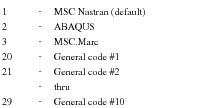XXXXXXXXXXXXXXXXXXXXXXXXXXXXXXXXXXXXXXXXXXXXXXXXXXXXXXXXXXXXXXXXXXXXXXXXXXXXXXXXXXXXXXXXXXXXXXXXXXXXXXXXXXXXXXXXXXXXXXXXXXXXXXXXXXXXXXXXXXXXXXXXXXXXXXXX''"> Invoking the Analysis Manager Manually
If installed properly, Patran’s Analysis Manager can be invoked from the system prompt with the following arguments:
$P3_HOME/p3analysis_mgr arg1 arg2 arg3 arg4 [optional args] [args5-8]
where $P3_HOME is a variable indicating the <installation_directory>, the directory location of the Patran installation.
Each argument is described in the following table.
Argument | Description |
arg1
(start-up type) | The program can be started up in one of the following 8 modes (enter the number only): 1 - Start up the full interface. See The Main Form. (default) 2 - Start up the Queue Monitor. See Monitor. 3 - Start up the Abort Job now. See Abort. 4 - Monitor a Running Job. See Monitor. 5 - Monitor a Completed Job. See Monitor. 6 - Submit the job. See Submit. 7 - Submit in batch mode. (No user interface appears or messages.) 8 - Same as 7 but waits until job is done. Returns status codes:
0=success, 1=failure, 2=abort. |
arg2
(extension) | This is the extension of the analysis input file (e.g., .dat,.bdf, .inp).
(.dat is the default) |
arg3 (jobname) | This is the Patran jobname; the jobname that appears in any jobname textbox (without the extension). (default = unknown) |
arg4
(application type) | This is the analysis application requested (enter the number only). |
optional args (MSC Nastran) | -coldstart coldstart_jobname The -coldstart parameter followed by the cold start MSC Nastran jobname indicates a restart job. Also see P3Mgr. |
optional args (ABAQUS) | -runtype <0, 1 or 2> -restart oldjobname The -runtype parameter followed by a 0, 1 or a 2 is to specify whether the run is a full analysis, a restart, or a check run respectively. The
-restart parameter is to specify the old jobname for a restart run. |
optional args
(MSC.Marc) | |
arg5 (x position) | Optional - Specifies the X position of upper left corner of Patran right hand side interface in inches. (UNIX only) |
arg6 (y position) | Optional - Specifies the Y position of upper left corner of Patran right hand side interface in inches. (UNIX only) |
arg7 (width) | Optional - Width of right-hand side interface in inches. (UNIX only) |
arg8 (height) | Optional - Height of right-hand side interface in inches. (UNIX only) |
If no arguments are provided, defaults are used (full interface (1), “.dat”, “unknown”, MSC Nastran (1)).
The arguments listed in the table above are very convenient when invoking the Analysis Manager from pre and postprocessors such as Patran, which have access to the pertinent information which may be passed along in the arguments. It may, however, be more convenient for the user to define an alias such that the program always comes up in the same mode.
Here are some examples of invoking Patran’s Analysis Manager:
$P3_HOME/bin/p3analysis_mgr
or
$P3_HOME/p3manager_files/p3analysis_mgr 1 bdf myjob 1
or
$P3_HOME/p3manager_files/p3analysis_mgr 1 bdf myjob MSC.Nastran
This invokes Patran’s Analysis Manager by specifying the entire path name to the executable where $P3_HOME is a variable containing the Patran installation directory. The entire user interface is brought up specified by the first argument. The input file is called myjob.bdf and the last argument specifies that MSC Nastran is the analysis code of preference.
Here is another example:
p3analysis_mgr 1 inp myjob 2 -runtype 1 -restart oldjob
p3analysis_mgr 1 inp myjob ABAQUS -runtype 1 -restart oldjob
This example invokes the Analysis Manager by assuming the executable name can be found in the user’s path. The entire user interface is brought up specified by the first argument. The input file is called myjob.inp. The code of preference is ABAQUS and the last two arguments indicate that a restart analysis is to be performed and the job is a restart from a previous job called oldjob. Another example:
p3analysis_mgr 3 dat myjob 20
This example requests the termination of an analysis by the jobname of myjob with an input file called myjob.dat. The analysis code specified is a user defined application defined by the number 20 in the configuration files.
p3analysis_mgr 5 dat myjob 1
This example requests the completed monitor graph of an MSC Nastran analysis by the jobname of myjob with an input file called myjob.dat.
If only the full interface is brought up by the user in stand-alone mode, it may be more convenient to specify an alias and place it in a login file (.login, .cshrc) such as:
alias p3am ‘p3analysis_mgr 1 dat unknown 1’
This way all the user has to type is p3am to invoke the program each time.
